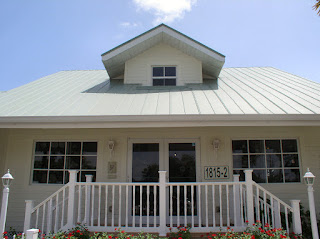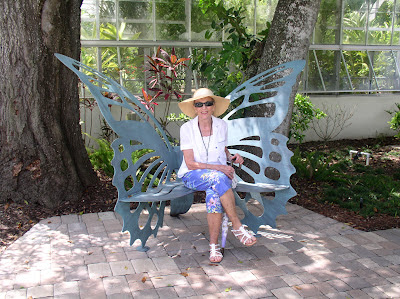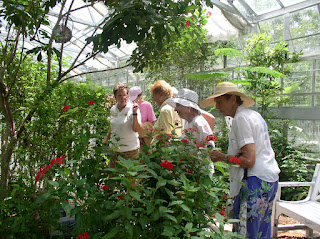Native Floridian and environmentalist Rob Johnson and his partner Matt Hoover wanted to bring the diversity of Southwest Florida’s subtropical environment to an urban setting, while at the same time reversing some environmental damage. Johnson says, “It‘s all about the environment. The more people we can get interested in helping the butterflies, the better off our eco-system will be.” After four years of planning and renovation, the partners opened the Butterfly Estates in 2004. Located in the Downtown Fort Myers River District, it is housed in three historic buildings that were originally built in the early 1900s and in a newly constructed 3,614-foot glazed glass butterfly conservatory. The Butterfly Estates faces a busy street, Fowler Street, but there are very lovely, lush gardens surrounding the buildings, especially in the back adjoining the parking lot.
Bay Oaks Social Seniors visiting the Butterfly Estates:
Director Patti, Martha, Ursula, Cora and Natalie
The grounds behind the Estates
The grounds along the pathway to the Estates buildings
An arched trellis along the pathway
Directional signage along the path
The entrance sign facing Fowler Street
The entrance to Mother Nature’s Gift Shop
Mother Nature’s Gift Shop was at one time an old Florida home, now renovated and still full of southern charm. You will probably find everything imaginable having to do with butterflies in this shop.
A flowering border in front of the gift shop
Cora in the gift shop
A butterfly umbrella hanging from the ceiling
Ursula and Patti checking out the framed artwork on the wall, which was made from butterfly wings.
Butterfly magnets roosting on a metal tree
Lots more butterfly objects in the gift shop
Shelves full of candles
A vine adorned by butterflies strung along the ceiling
Mushroom pottery and butterflies
A very large wall butterfly and crystal mugs
Ursula on this charming butterfly chair outside the conservatory
A metal butterfly sculpture in the garden
A Dedication Butterfly just outside the Butterfly Conservatory
Danielle, The Assistant Events Planner for the Estates and Joyce, the Conservatory Manager, and our docent for this tour
In the lobby of the Conservatory there are displays that show the life cycles of butterfly species. The first display is of the Great Southern White caterpillar with its food, pieces of lettuce, on the floor of the display case. The adult male butterfly is white with a black zigzag pattern on the outer margin of the forewing. The color of a female’s zigzag pattern is smoky grey.
Look closely on the plant stems to see the Black Swallowtail caterpillars.
The adult butterfly is predominantly black with yellow markings near the margins of the forewings and hind wings and some blue and red markings on the hind wings.
A Polydamus swallowtail caterpillar
The adult butterfly is black with accents of yellow and red. Its host is the pipevine plant.
The Gulf Fritillary caterpillar hanging on to the side of the display case
The adult is bright orange with black markings, and the underside is buff with large silvery spots.
Atala chrysalises clinging to a coontie plant
The Atala is a Florida native butterfly whose host plant is the coontie. The adult butterfly is predominantly black with blue specks on the hind wings and a red abdomen.
A shadowbox display case of different kinds of butterflies. Can you spot the adult versions of the caterpillars which were in the display cases?
The entrance to the Butterfly Conservatory, which was designed by a local architect and has an area of 3,614 square feet.
The path from the entrance winds past a bench and trellis
Fenced paths lead the way through the conservatory.
Docent Joyce points out leaves where butterflies have laid their eggs.
A Swallowtail caterpillar on a plant stem
Plants in the conservatory provide food for the caterpillars, so the host plants must be continually replenished.
The Monarch butterfly has just emerged from its chrysalis, which is still hanging from the stem, right beside the butterfly on its left.
The newly-emerged butterfly must now dry its wings before it can fly.
The conservatory has many host and nectar plants, trees and shrubs in a natural park setting.
Cascading waterfalls add a tropical feel to the park-like setting.
Numerous gold fish in the pond
Koi in the pond
A pathway leading to the back of the conservatory
Toward the back of the conservatory on the right hand side
A lovely corner of the conservatory
A Monarch butterfly
These butterflies constantly “flutter by,” so it’s not easy to get a photo of them.
Examining the plant life with docent Joyce
Toward the back of the conservatory on the left hand side
Another lovely cascading waterfall in a natural setting
A look backward at the conservatory
Ursula, Patti and Joyce admire the Desert Rose in a tall and handsome blue pot.
This is the first white Desert Rose I’ve ever seen. They are usually pink, magenta or red, as its name might suggest.
Looking toward the entrance to the conservatory
A look back at the conservatory on the way out
A Giant Swallowtail butterfly spreading his wings and staying still long enough for me to take his photo
Joyce is answering questions at the end of the tour. She is a goldmine of information and a great advocate for butterflies.
Tables and umbrellas at the Outdoor Café
Entrance to Flutterby’s
Flutterby’s Café is in a renovated home that was originally built in 1913. Visitors can dine inside, or outside on the wrap-around porch.
Flutterby’s Café is in a renovated home that was originally built in 1913. Visitors can dine inside, or outside on the wrap-around porch.
A Nathaniel Hawthorne quote is front and center as you enter the café.
The Caterpillars Ice Cream & Fudge Factory is located in a remodeled 1914 historic home.
The Bakery in Caterpillars
I bought a piece of the chocolate cake, which had a layer of cream cheese inside. It was incredibly good and also incredibly rich.
As we left the Butterfly Estates, Gators fan Patti took one last look at the Florida mascot.



























































No comments:
Post a Comment